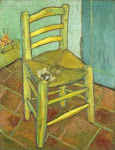
Around mid-November 1888, while in Arles, van Gogh painted this "liseuse de romans," or novel-reader, today in a private collection (click on image to enlarge). She is rendered in a sketchy, expressionistic style and seems to have been an experimental piece on Vincent's part, namely because he was not working from a model, his usual practice. He painted this figure from his imagination, and if he based her on someone he knew, we don't know her identity. In the letter to his sister Wilhemina in which he describes this picture (W9), Vincent mentions his house-guest, Paul Gauguin, adding that Gauguin "strongly encourages me to work often from pure imagination." As someone who preferred to base his pictures in something tangible, even if he altered reality in the end, Vincent found this technique "de tête" a challenge.
Particularly noteworthy here is the book in the woman's hands. To a viewer of our time it seems innocuous, but a viewer of Vincent's day would instantly identify the book as a "modern" novel, typically published as yellow-covered paperbacks. Books are a recurring motif in van Gogh's work; often he depicts the novels that he enjoyed so much, by authors like Zola or the Goncourts. But such novels were acceptable reading for a man -- not for a woman. Vincent differed from most men of his time in believing women *should* read modern novels, so they themselves could be modern in thinking and worldview. As art historian Judy Sund* says it, for "this imagined female...[to be] reading a yellow book (i.e. a modern novel) with wide-eyed attention reflects the artist's conviction that everyone should read, and suggests anew that his conception of the ideal woman included a devotion to the modern fiction that was modelled on his own" ("Favoured Fictions," p. 260). Vincent's surviving letters to his sister Wil include many reading recommendations. In the letter mentioning "La Liseuse de Romans," he says, "It is a very good thing that you have at last started to read Au Bonheur des Dames" [a novel by Emile Zola about a girl working in a Parisian department store]. We can contrast Vincent's attitude with his brother Theo, who says in a letter to a female acquaintance (T1a), "...so many fine things are written that one can hardly discuss, at least with ladies. Zola, Guy de Maupassant and others will go on belonging to the forbidden fruits for a long time to come." One wonders what he thought of Vincent's encouraging Wil to read exactly those books!
*Judy Sund, "Favoured Fictions: Women and Books in the Art of Van Gogh," Art History 11, 2 (June 1988) 255-267.






1 comment:
I'm conscious that I'm commenting 14 years late, but thank you for this enlightening post. I arrived here after googling the picture in English, but it's helpful that your refer to the original French name (or perhaps Vincent would have thought of it in Dutch?). I'm studying creative writing, and this painting is on the cover of my Penguin copy of David Lodge's book The Art of Fiction, so I was intrigued and wanted to know more about it. Thanks, again.
Post a Comment